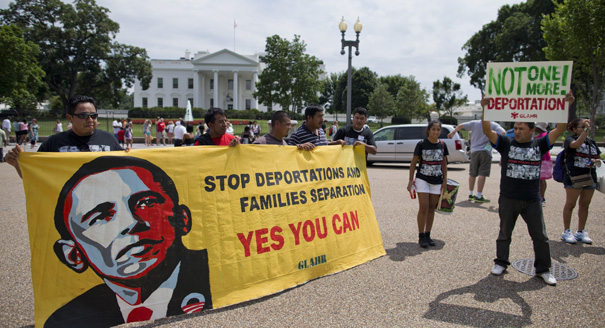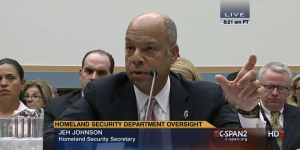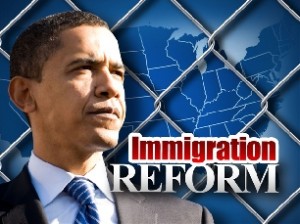
What the president CAN do on immigration
By Marshall Fitz
WASHINGTON, D.C. – With immigration reform legislation stalled, and deportations reaching a crisis level, President Barack Obama asked his new secretary of homeland security, Jeh Johnson, to conduct a review of the agency’s deportation policies in order to identify ways to make the system more humane. While that review process continues, this report provides a roadmap for executive action on immigration by analyzing the scope of the problem, the legal authority underpinning administrative reforms, the various administrative mechanisms available to the president, and the groups of individuals who could still be protected if Congress fails to act.
In June 2013, the Senate passed a historic bipartisan immigration reform bill: the Border Security, Economic Opportunity, and Immigration Modernization Act, or S. 744. The legislation would revamp our legal immigration system and create a pathway to citizenship for the 11.7 million unauthorized immigrants living in the United States. This long overdue reform was embraced by virtually all stakeholders in the debate and supported by strong majorities of American voters from across the political spectrum.
Since the Senate bill passed, however, House Republican leaders have talked about the need for reform but refused to bring legislation to the floor. For example, House Speaker John Boehner (R-OH) circulated a set of “standards” designed to guide the House consideration of immigration reform legislation in January. Less than a week later, he put those standards on hold, declaring that his party’s distrust of President Obama made it too difficult to consider reform this year.
While Congress has repeatedly tried and failed to reform our immigration laws over the past 10 years, Congress—along with successive presidential administrations—has nonetheless succeeded in escalating the enforcement of the existing broken laws. And the impact of that increased enforcement on American families, businesses, and communities has reached a crisis level. Two-thirds of all unauthorized immigrants currently living in the United States have resided here for more than a decade and are long settled and well integrated into our communities. Yet immigrants are being deported in record numbers: More than 4 million people have been removed from the United States since 2001, with 2 million people removed during the Obama administration alone.
The removal of these 2 million people is equivalent to wiping out the entire combined populations of Boston, Miami, Seattle, and St. Louis. Moreover, an estimated 200,000 parents of U.S. citizen children were deported over the two-year period between 2010 and 2012. The Applied Research Center found that 5,100 children of immigrants were in the foster care system in 2011 because their parents were detained or deported. These removals devastate communities and leave broken families behind in the United States. And these enforcement efforts have come at a heavy cost to taxpayers: The United States now spends $3.5 billion more on immigration and border enforcement—a total of nearly $18 billion per year—than it does on all other federal law enforcement combined. That breathtaking figure is higher than the annual gross domestic product, or GDP, of 80 different countries.
 President Obama has argued that he does not have the authority to simply stop deportations for all undocumented immigrants. In one critical sense, he is right: Only legislation can provide a permanent solution that includes a path to legal status and eventual citizenship for the 11.7 million unauthorized immigrants living in the country. Any administrative relief via executive action is temporary, could be reversed by a subsequent administration, and likely cannot cover the entire undocumented population. In other words, such relief would, almost by definition, be inadequate and incomplete.
President Obama has argued that he does not have the authority to simply stop deportations for all undocumented immigrants. In one critical sense, he is right: Only legislation can provide a permanent solution that includes a path to legal status and eventual citizenship for the 11.7 million unauthorized immigrants living in the country. Any administrative relief via executive action is temporary, could be reversed by a subsequent administration, and likely cannot cover the entire undocumented population. In other words, such relief would, almost by definition, be inadequate and incomplete.
But as this report highlights, President Obama can still do much more administratively to make immigration enforcement more rational and humane while Congress delays. This is because the administration has wide latitude in establishing its enforcement priorities, including deciding how to spend the resources that Congress appropriates for immigration enforcement, and whether to pursue enforcement against certain individuals. It also has the discretion to identify individuals with certain equities—mitigating factors such as family or community ties, employment history, or length of residence in the United States—and authorize them to affirmatively request temporary relief from deportation.
This report begins by providing an overview of the current problems facing our broken immigration system—including a profile of unauthorized immigrants, a review of the rise in enforcement, and a description of the legislative gridlock delaying reform. It then discusses the legal authority for executive action on immigration and explores several administrative mechanisms that the president could adopt to make enforcement more sensible and humane. These mechanisms can be divided in to two related but distinct types of policies:
- Enforcement reforms, which involve prioritizing how and whether enforcement is conducted when someone comes into contact with the authorities. Regardless of whether Congress moves forward with immigration reform legislation, DHS should adopt these types of reforms to our enforcement policies as soon as possible.
- Affirmative relief, which involves identifying low-priority individuals and creating a procedure for them to come forward and affirmatively seek temporary protection from deportation.
This report focuses primarily on the affirmative relief policies that are available to the administration. It describes three mechanisms that have been used to grant affirmative relief in other contexts: deferred action, parole in place, and deferred enforced departure. The report then evaluates them according to two basic criteria: the program’s potential impact—both its size and the ability to maximize it—and workability—its flexibility and feasibility.
Although all three mechanisms have certain advantages, deferred action carries the fewest operational restrictions and is therefore the optimal mechanism both for protecting the broadest number of individuals and for successful and efficient implementation.
Lastly, this report examines the various equities that the president should consider when deciding who to designate as low priorities and who to protect from removal. These factors include:
- Likelihood of legislative protection, such as people who would be eligible for legalization under S. 744
- Family ties, such as undocumented parents of children living in the United States or people with a qualifying relationship that would make them eligible for permanent residency
- Employment background, such as workers from industries with large undocumented workforces
- Duration of residence, such as individuals who have been living in the United States for enough time to have deep roots in and ties to the community
According to Congressional Budget Office, or CBO, estimates for S. 744, a program based on the likelihood of legislative protection could cover as many as 8.3 million people. There are an estimated 4.7 million undocumented parents with a minor child living in the United States, including 3.8 million whose children are citizens. Estimates of the undocumented workforce range from 6.4 million to 8 million, with nearly 1.5 million working in the retail trade sector and more than 1 million in the agricultural sector. Finally, almost 7.5 million unauthorized immigrants have lived in the country for more than a decade.
Because an immigrant may have more than one of these equities—for example, an agricultural worker may have been here for more than a decade—these numbers are not additive. Either way, they point toward a large number of people with strong equities who could be protected from deportation.
By expanding the use of deferred action beyond DACA to other individuals with compelling equities, President Obama could help stabilize families, communities, and local economies across the country. It would also make our country safer by ensuring that resources are focused on individuals who have committed serious crimes and pose a danger to society. Such action would be, by definition, incomplete and the need for meaningful legislative reforms would remain. But it would help begin the process of fixing the system and is a lawful, just, and necessary response to an immigration enforcement crisis that Congress has cultivated through inaction.
Marshall Fitz is the Director of Immigration Policy at the Center for American Progress.
(From Center for American Progress)

